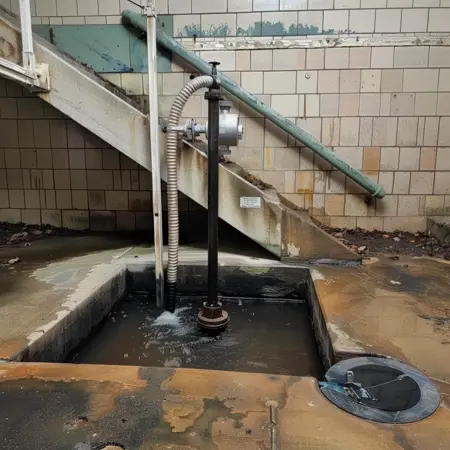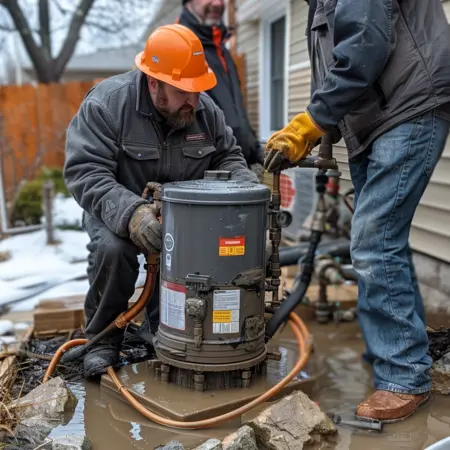Are you curious about how much it costs to install a sump pump?
Knowing the price for installation and repair can help you decide what’s best for your home.
Get ready to explore the sump pump installation costs and many more.
Key Takeaways
- Installing a sump pump across the country costs about $1,400 in 2024.
- If your basement already has a pit, installing it will cost less.
- The cost of installing a sump pump depends on several factors.
- Submersible pumps are quieter and more powerful than pedestal pumps, making them ideal for tough tasks.
- The cost to dig and prepare the pit depends on your floor type.
- Keeping your sump pump happy doesn’t have to break the bank.
- Banks offer special loans for home improvements that you can use.
Sump Pump Installation Cost
There isn’t a one-size-fits-all answer.
But on average, installing a sump pump across the country costs about $1,400 in 2024.
Yet, the price can vary quite a bit, anywhere from $500 to $4,000, depending on your home’s specific needs.
There are different types, but most homes use an underwater pump that sits in a hole underground.
If your basement already has a pit, the installation becomes affordable.
Ensure a secure home with our professional sump pump installation services.
Get in touch with us now at Sump Pump Services.
Factors Affecting Installation Costs
Installing a sump pump involves several factors that can affect how much it costs.
Understanding these factors can help you plan and budget for installing a sump pump in your home:
1. Type Of Pump
There are two main types of sump pumps – pedestal pumps and submersible pumps.

A. Pedestal pumps
These sit above the water level in the pit.
They’re easier to get to for fixing, but they can be louder because they’re not under the water.
Also, they usually cost less than submersible pumps.
B. Submersible Pumps
These are placed under the water in the pit.
They’re quieter and stronger than pedestal pumps, so they’re great for tough jobs.
Because of their power, they cost more than pedestal pumps.
2. Digging The Pit
The cost of digging and preparing this pit depends on what your floor is made of:
- Dirt (Sand) Floor: If your basement has a dirt floor, digging the pit is simpler and less expensive.
- Concrete (Solid) Floor: Digging the pit can be harder and more expensive if your basement floor is concrete.
3. Labor
The labor cost is less if the installation is straightforward and doesn’t take long, and vice versa.
Some installations need more skills, especially with tight spaces and difficult access.
4. Materials
Along with the pump itself, you’ll need other materials to complete the installation:
- Pipes: These carry water from the pit to a safe drainage area.
- Pit Cover: A cover for the pit keeps debris out and reduces the risk of accidents.
- Fittings: Connect the pipes and the pump, ensuring everything works together.
5. Location
Where you live also affects the cost of installing a sump pump.
In some areas, the cost of materials and labor might be higher than others.
Local rules can affect what’s needed for installation, impacting costs.
Getting Different Rates Throughout The Market
Getting rates from different contractors helps you find the most suitable price.
It lets you compare and choose the one that fits your budget.
Ask professionals about their experience and how they’ll do the job.
Find out about their warranty and when they can start.
Look at what’s included in each rate and service.
Check if it covers all the work and materials needed.
This helps you avoid surprises later on.
Top 3 Cost Saving Tips
Want to save money on sump pump installation?
Here are three simple tips to help you cut costs:
1. DIY Options For Simple Installations
You can save money by doing simple sump pump installations if you have the skills and tools.
This avoids paying for professional labor.

2. Comparing Prices From Different Plumbing Contractors
Check prices from different pros to find the best deal.
Sometimes, prices vary, so it’s smart to see around before deciding.
3. Taking Advantage Of Seasonal Discounts
Look for discounts and special offers during certain times of the year.
Contractors offer sales that can save you money on sump pump installations.
Bonus Tip – Financing Options
Explore how you can afford your sump pump installation with these financing options:
1. Exploring Options For Sump Pump Installations
If you need help paying for a sump pump, there are ways to finance it.
Some pros offer payment plans so you can pay over time instead of all at once.
2. Government Support For Flood Prevention
The government gives money back to people who install sump pumps to prevent flooding.
It’s worth checking if there are any programs where you live.
3. Financing Through Home Improvement Loans
You can also get a loan to pay for a sump pump.
Banks have special loans for home improvements that you can use for this.
Regular Maintenance Costs
The sump pump needs a little care to stay in top shape.
Keeping your sump pump happy doesn’t have to break the bank.
Here are some easy ways to do it:
1. Regular Maintenance Requirements For Sump Pumps
Sump pumps need regular attention to work well. This includes:
- Cleaning: Removing dirt and debris from the pump and pit.
- Testing: Checking if the pump turns on and pumps water correctly.
- Checking The Discharge Pipe: Make sure water flows out properly.
2. Cost Of Annual Inspections And Servicing
It’s smart to have a professional check your sump pumps every year.
This costs around $100 to $200.
They’ll make sure everything works right and fix any problems early.
3. Why Planning Maintenance Is Important
Thinking about maintenance costs is important. It helps:
- Prevent Problems: Regular checks can catch issues before they get big.
- Save Money: Fixing small problems costs less than fixing big ones.
- Keep Your Home Safe: A working sump pump stops water damage, which can be costly.
DIY Vs. Professional Installation
Are you thinking about installing a sump pump yourself to save some cash?
But before you grab your toolbox, let’s see the pros and cons of DIY work vs. calling in a professional plumber:
1. Pros And Cons Of DIY Installation
Let’s talk about the good and bad of doing it yourself:
- Pros: You might save money, and it can feel good to do it yourself.
- Cons: It can be tricky, and mistakes might happen. You might need special tools and skills.
2. Pros And Cons Of Professional Installation
Hiring a pro, too, comes with pros and cons:
- Pros: They know what they’re doing and can finish the job safely, providing a warranty.
- Cons: It can cost more money, and you’ll have to wait for them to install the pump.

3. Possible Cost Savings And Risks Involved
- DIY: Installing the sump pump yourself might save on paying someone else.
- Risks: If something goes wrong, fixing it can cost more. Professionals know what they’re doing.
4. Factors To Consider Before Deciding
Before you choose, consider these points:
- Time: Doing it yourself can take longer.
- Skills: Do you know how to do it? Some jobs are tricky.
- Safety: Working with water and electricity can be dangerous.
Conclusion
This article covers the cost of installing a sump pump, what affects these costs, and ongoing care.
The pros and cons of choosing between DIY and hiring a professional have been discussed.
It also discusses price differences in the market, money-saving tips, and financing options.
Are you thinking about getting a sump pump installed?
Contact us today at OP Plumbing Hub.
We’ve got you covered with expert advice and installation services.
